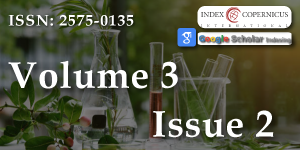Determination of anthocyanin content in two varieties of Hibiscus Sabdariffa from Selangor, Malaysia using a combination of chromatography and spectroscopy
Main Article Content
Abstract
The calyces of Hibiscus sabdariffa have been used by many communities as herbal tea. Their anthocyanin contents have been reported as the key component in anti-obesity studies. This present work reported results of anthocyanin content of calyces in two varieties of H. sabdariffa collected from Sabak Bernam, Selangor, Malaysia. The samples have been authenticated in the Herbarium, Institute of Bioscience, University Putra Malaysia prior to the study. The samples were processed and the ground dry raw material and its aqueous extract were analyzed using Fourier Transform Infrared (FTIR) and Two-Dimensional Infrared (2DIR). The short hybrid calyces (FT11-15A) raw material spectrum showed more than 80% similarity with long wild variety calyces (FT11-15B) when using “Compare” in analysis. The differences of both samples were obviously shown in their aqueous extract spectra. The peak at 1672 cm-1 and 841 cm-1 showed that tri-substituted double bond in FT11-15B aqueous extract was not present in FT11-15A aqueous extract spectra, whereby a double peak was assigned at 1221 cm-1 referred to anti symmetry stretching of aromatic and vinyl =C-O-C- with other =C-O- and 1192 cm-1 is assigned In-plane δ C-H in FT11-15A aqueous extract. The peak at 1071 cm-1 assigned as bonding C-H in plane bending of phenyl of both samples was the only peak comparable with standard delphinidin and cyanidin which are used for qualification and quantification of sample content. Aqueous extract spectra of both samples showed higher number of peaks detected compared with raw material spectra, which was attributed to the higher solubility of anthocyanins in water. The 2DIR correlation spectroscopy is advantageous in enhancing the qualitative analysis of herbal products. The anthocyanin content in both varieties of H. sabdariffa in descending amount is delphinidin-3-O-sambubioside (DS), cyanidin-3-O-sambubioside (CS), delphenidin-3-O-glucoside (DG) and lastly cyanidin-3-O-glucoside (CG). FT11-15A has more content of DS and DG of raw material and CG of water extract plus TFA than FT11-15B, whereby, FT11-15B has more content of CS, CG of raw material and DS, DG, CS of water extract plus TFA than FT11-15A.
Article Details
Copyright (c) 2019 Choong YK, et al.

This work is licensed under a Creative Commons Attribution 4.0 International License.
Mariod AA, Saeed Mirghani ME, Hussein I, Mariod AA, Saeed Mirghani ME, et al. Hibiscus sabdariffa L. Roselle. Unconventional Oilseeds and Oil Sources. 2017; 59-65.
Riaz G, Chopra RA. review on phytochemistry and therapeutic uses of Hibiscus sabdariffa L. Biomedicine & Pharmacotherapy, 2018; 102: 575-586. PubMed: https://www.ncbi.nlm.nih.gov/pubmed/29597091
Fallahi HR, Ramazani SHR, Ghorbany M, Aghhavani-Shajari, M. Path and factor analysis of roselle (Hibiscus sabdariffa L.) performance. Journal of Applied Research on Medicinal and Aromatic Plants. 2017; 6: 119-125.
Cercato LM, White PAS, Nampo FK, Santos MRV, Camargo EA. A systematic review of medicinal plants used for weight loss in Brazil: Is there potential for obesity treatment? Journal of Ethnopharmacology. 2015; 176, 286-296. PubMed: https://www.ncbi.nlm.nih.gov/pubmed/26520790
Hirunpanich V, Utaipat A, Morales NP, Bunyapraphatsara N, Sato H,et al. Hypocholesterolemic and antioxidant effects of aqueous extracts from the dried calyx of Hibiscus sabdariffa L. in hypercholesterolemic rats. Journal of Ethnopharmacology. 2006; 103, 252-260. PubMed: https://www.ncbi.nlm.nih.gov/pubmed/16213683
Ojeda D, Jiménez-Ferrer E, Zamilpa A, Herrera-Arellano A, Tortoriello J, et al. Inhibition of angiotensin convertin enzyme (ACE) activity by the anthocyanins delphinidin- and cyanidin-3-O-sambubiosides from Hibiscus sabdariffa. Journal of Ethnopharmacology. 2010; 127: 7-10. PubMed: https://www.ncbi.nlm.nih.gov/pubmed/19808084
Yang B, Liu H, Yang J, Gupta VK, Jiang Y. New insights on bioactivities and biosynthesis of flavonoid glycosides. Trends in Food Science & Technology. 2018; 79: 116-124.
Zheoat AM, Gray AI, Igoli JO, Ferro VA, Drummond RM. Hibiscus acid from Hibiscus sabdariffa (Malvaceae) has a vasorelaxant effect on the rat aorta. Fitoterapia. 2019; 134: 5-13. PubMed: https://www.ncbi.nlm.nih.gov/pubmed/30690125
Jackson RD, Isidore B, Cates RL. Are plant-soil dynamics different in pastures under organic management? A review. Agriculture, Ecosystems & Environment. 2019; 279: 53-57.
Juhari NH, Bredie WLP, Toldam-Andersen TB, Petersen MA. Characterization of Roselle calyx from different geographical origins. Food Research International. 2018; 112, 378-389. PubMed: https://www.ncbi.nlm.nih.gov/pubmed/30131149
Sharma HK, Sarkar M, Choudhary SB, Kumar AA, Maruthi RT, et al. Diversity analysis based on agro-morphological traits and microsatellite based markers in global germplasm collections of roselle (Hibiscus sabdariffa L.). Industrial Crops and Products. 2016; 89: 303-315.
Osman Mohamad, Saberi S, Nezhadahmadi Arash, Faruq Golam. Development and Evaluation of Fruit Related Morphological and Physico-Chemical Characteristics in Three Roselle Mutants. Pakistan Journal of Nutrition. 2014; 13.
Ma’arup R, Aziz MA, Osman M. Development of a procedure for production of haploid plants through microspore culture of roselle (Hibiscus sabdariffa L.). Scientia Horticulturae. 2012; 145: 52-61.
Mahadevan N, Shivali A. and Kamboj P. Hibiscus sabdariffa Linn.-An overview. Natural Product Radiance. 2009; 8: 77-83. https://essentia.com.br/images/artigos/ativos-nov-2016/Tintura%20Hisbiscus.pdf
Tham TC, Ng MX, Gan SH, Chua LS, Aziz R, et al. Impacts of different drying strategies on drying characteristics, the retention of bio-active ingredient and colour changes of dried Roselle. Chinese Journal of Chemical Engineering. 2018; 26: 303-316.
Lu, Y., Wu, N., Fang, Y., Shaheen, N., & Wei, Y. An automatic on-line 2,2-diphenyl-1-picrylhydrazyl-high performance liquid chromatography method for high-throughput screening of antioxidants from natural products. Journal of Chromatography A. 2017; 1521: 100-109. PubMed: https://www.ncbi.nlm.nih.gov/pubmed/28939230
Jiao L, Guo Y, Chen J, Zhao X, Dong D. Detecting volatile compounds in food by open-path Fourier-transform infrared spectroscopy. Food Research International. 2019; 119: 968-973. PubMed: https://www.ncbi.nlm.nih.gov/pubmed/30884737
Smith MJ, Holmes-Smith AS, Lennard F. Development of non-destructive methodology using ATR-FTIR with PCA to differentiate between historical Pacific barkcloth. Journal of Cultural Heritage. 2019.
Hua R, Sun SQ, ZhouQ, Noda I, Wang BQ. Discrimination of Fritillary according to geographical origin with Fourier transform infrared spectroscopy and two-dimensional correlation IR spectroscopy. Journal of Pharmaceutical and Biomedical Analysis. 2003; 33: 199-209. PubMed: https://www.ncbi.nlm.nih.gov/pubmed/12972085
Zuo L, Sun S, Zhou Q, Tao J, Noda I. 2D-IR correlation analysis of deteriorative process of traditional Chinese medicine ‘Qing Kai Ling’ injection. Journal of Pharmaceutical and Biomedical Analysis. 2003; 30: 1491-1498. PubMed: https://www.ncbi.nlm.nih.gov/pubmed/12467920

